| Area | Upper Klamath |
| Topic | Tour: Fisheries Research |
Lost River sucker being measured and weighed. This species and the short-nose sucker are native to the Upper Klamath Basin and are both on the Federal Endangered species list. These fish can live to be up to 40 years old and can grow to more than three feet in length. Photo courtesy of Mark Buttner, Bureau of Reclamation.
Crew equipped with portable, backpack electroshockers collect fish during a survey. Fish are only stunned when collected and can be released after being identified to species, measured and weighed. Photo courtesy of Mark Buttner, Bureau of Reclamation.
Fisheries biologist uses an electroshocking device from a drift boat in the Williamson River to collect a sample of fish. Fish are attracted to the positive pole and the biologist in the front of the boat uses the long net to capture them. Fish are only stunned and can be released after essential information is collected. Photo courtesy of Mark Buttner, Bureau of Reclamation.
Biologists use nets in the margin of Upper Klamath Lake to check for use at different summer periods by sucker fish of different age classes. Photo courtesy of Mark Buttner, Bureau of Reclamation.
Bureau of Reclamation biologists perform micro-surgery on an adult short-nose sucker to implant a radio tag. This allows scientists to track the movements of these fish and show seasonal patterns of use of different areas of Upper Klamath Lake and its tributaries. Photo courtesy of Mark Buttner, Bureau of Reclamation.
Bureau of Reclamation fisheries biologist checks the margins of the Lost River for juvenile sucker larvae. Photo courtesy of Mark Buttner, Bureau of Reclamation.
Bureau of Reclamation fisheries biologist holds up dead sucker fish during a fish kill on Upper Klamath Lake in 1995. Algae blooms during warm summer periods can cause periods of extremely low dissolved oxygen in the lake which can be lethal to some fish species. Photo courtesy of Mark Buttner, Bureau of Reclamation.
The Klamath Tribe has experimented with artificial culture of sucker species at a hatchery near Chiloquin. Both Lost River and short-nosed suckers proved difficult to culture so habitat restoration seems the only effective avenue for their recovery.
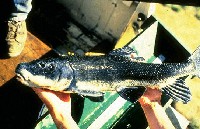 Click on image to enlarge (62K).
Click on image to enlarge (62K).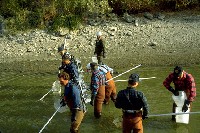 Click on image to enlarge (74K).
Click on image to enlarge (74K).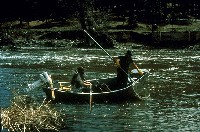 Click on image to enlarge (70K).
Click on image to enlarge (70K).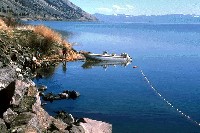 Click on image to enlarge (56K).
Click on image to enlarge (56K).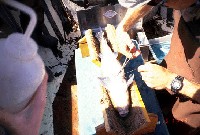 Click on image to enlarge (56K).
Click on image to enlarge (56K).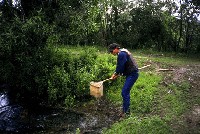 Click on image to enlarge (73K).
Click on image to enlarge (73K). Click on image to enlarge (47K).
Click on image to enlarge (47K).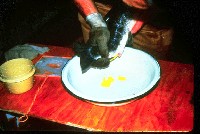 Click on image to enlarge (52K).
Click on image to enlarge (52K).
To learn more about this topic click Info Links
To view additional information (data source, aquisition date etc.) about this page, click Metadata
| www.krisweb.com |
